Selectel tour: DC "Technodom"
“The idea to post photos from our DC was born a long time ago. But that time is not there, then amateur photographers, like me, are not the hands of that place are growing, then something else. Finally, free time and straight hands come together.
In this series of articles, we show how our DC look like.
So, the oldest data center of Selektel (from which the company, in fact, started), under the code name "Technodom" .
')
A small video tour:
It is also a machine room, payload (literally) for any data center. It is here that there are small pieces of fused silicon, for which all the rest of the equipment and people work.
(pictures are clickable)

Traditionally, the main format used for server placement is 19 "(19 inches), their height is measured in units (vershok, hehe). Servers are tightly mounted one above the other in special cabinets with vertical rails. Cabinets are sometimes also called" resistant ". In Technodom, 42 U cabinets are used in size (the inner rails have a height of 42 units, plus a little below, plus a little on top, plus a little from the sides to the walls and space for cables - that is, the actual size of the cabinet is larger than 1.8 meters high and 48 centimeters in dl well). The actual useful cabinet load somewhat less, as there still are mounted outlet (also 19 "). The dimensions of the cabinet itself: height 2030, width 600 mm. The depth of the cabinets is different - 620, 820 and 1020mm to choose from.
(under the cut - more photos of the server, equipment and people)
<habracut />
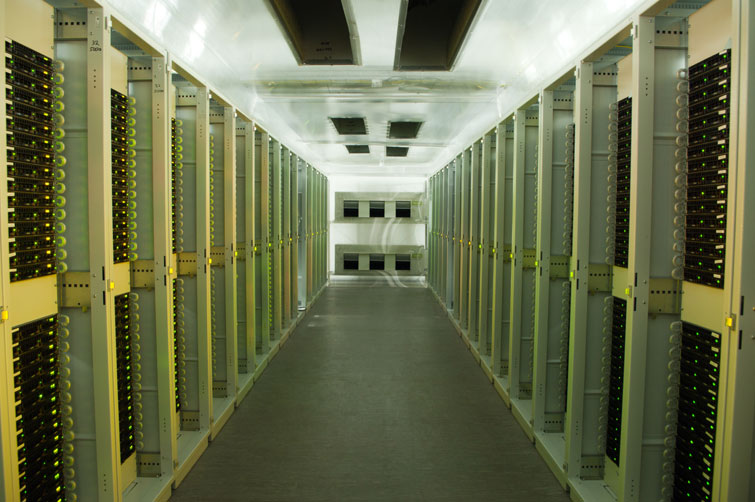
Selectel traditionally uses the cold corridor model: Cold air under pressure is injected into the corridor, from where server fans take it and thrown into the “hot corridor”, which is not, in the first place, hot, and secondly, not the corridor - this is all free server space except the "cold corridors". The cold corridors are really cold, it's uncomfortable for a long time there. The SLA recorded a promise to keep the temperature there + 20 ± 2 ° , degrees, in reality there are usually these same + 20-2. And taking into account the constant cold drafts from ventilation (in this place and all 15 degrees can be), this place is definitely not for humans.
A cold corridor is formed by two rows of cabinets (they make the side walls of the corridor), a roof on top and light doors on both sides of the corridor.
All servers are mounted so that the air intake slots face the cold corridor (usually the server faces), and the hot air is blown out (it is taken by the air-conditioning system, chased through filters, dried / moistened, cooled, and started back into the cold corridor ).
In the photos server side view in the cold corridor. The total area of DC is three and a half thousand square meters. Useful capacity - 320 cabinets (13440 units), placed on 1400 square meters of server space.

Unification does its own (black?) Business - despite the fact that these are photos of three different cold corridors, you can understand that they can be different only by this proposal (consider this a game of attentiveness - find 16 differences between the corridors).
Most servers have power connectors, network connections, etc. from the “hot” side, so that all work on switching, connecting / disconnecting, etc. it is from there.

This photo clearly shows the horizontal cable channel - it is used to connect the servers to the network (and among themselves).

So that in the cold corridors it waswarm and cozy, cold and dry, you need a powerful cooling system. Unlike delicate silicon pieces, air conditioner coolers are designed for outdoor use.
We did a little bit differently - the coolers are placed in the pass-through corridor that protects them from rain and bird bombardment.

On both sides of the fan to blow hot air from the air conditioner. A standard N + 1 scheme is used (that is, an idle hotspar costs). Lessar air conditioners.
It is a close-up view:
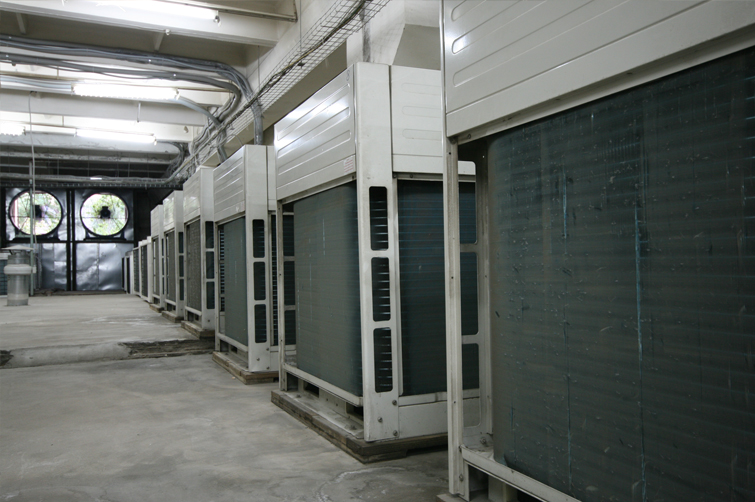
What is more important for a data center - electricity or the Internet?
3 megawatts of power. Of course, bespereboynik and diesel generators. Probably, there should tell a lot of interesting things about electricity, but this is not my element. I can only say that, for example, they don’t allow me to enter the premises of the electric economy (there is no necessary access - there are six kilovolts). Two inputs are serviced by 4 transformers, 380 volts are going to the boards, the usual 220 are already going to all the equipment.
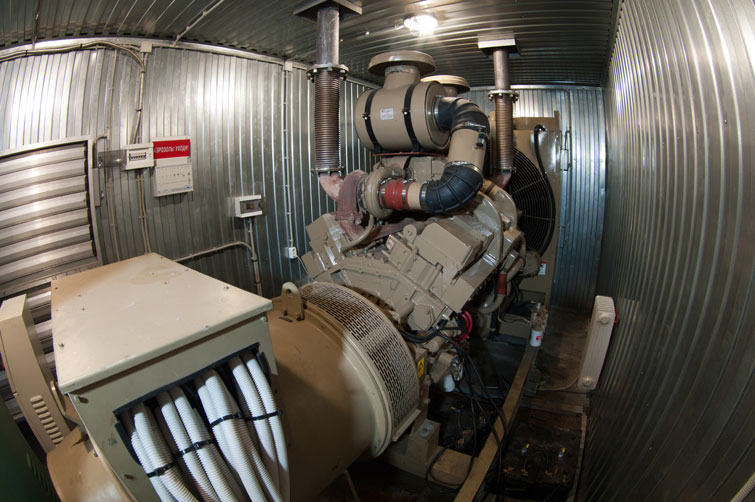
Pay attention to the battery - at the time when the entire civilized server is cooled, the container with the generator is heated. Blinds (horizontal metal strips) are automatic, open simultaneously with the inclusion of the generator.
Generators - 4 pcs. Three are located on the street, one, just in case, in the building (in a separate room with separate ventilation, of course). Start automatic.
Periodically (about once a month) they are turned on for testing, according to my impressions I can say that the burned diesel fuel for several megawatts does not smell very good.
A little about diesel generators (I went to the technical director for details) - each diesel generator has two starters, their own bespereboynik to start (already two pieces).
Below you can see one of these batteries:
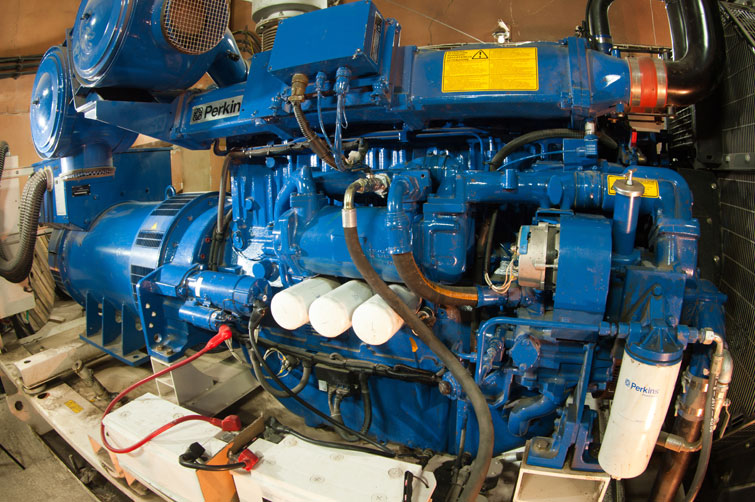
For a while, while the generators turn on, of course, there are uninterruptible power supplies. They are in a separate room. These are industrial electric packs of General Electric, collected in 4 clusters (plus traditional hotspars).
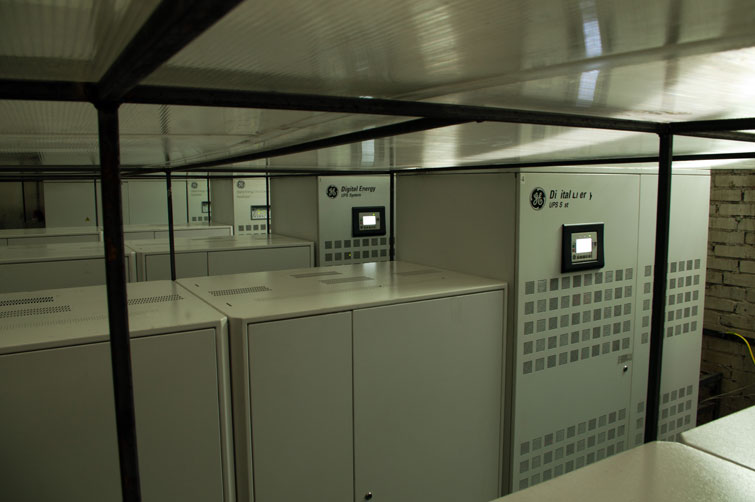
What is more important for a data center - electricity or the Internet? In fact, the “Internet” is too narrow a concept for a DC, connectivity is important for it. Not all links leaving the data center are the Internet, many of them are private networks, gray fibers that combine individual servers into a single structure, etc.
All DC Selectlel have links to each other through our optics. (Map of the passage of links: selectel.ru/services/rentvols )
Holy of Holies, communications site:
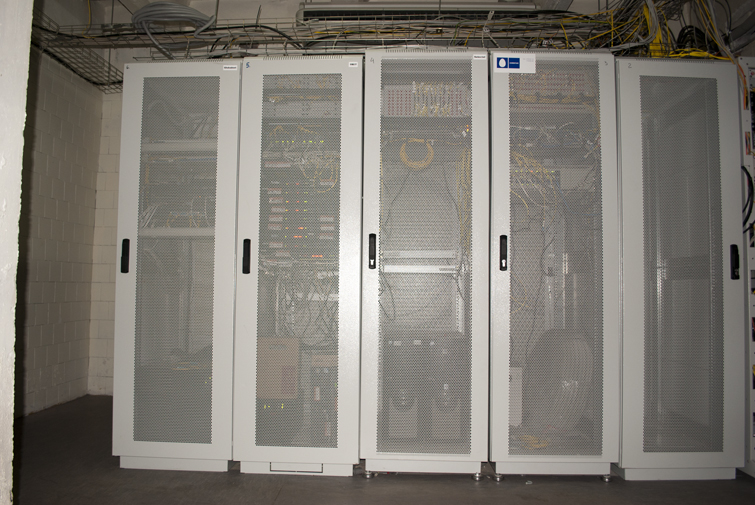
Of course, there are direct links to places of maximum Internet concentration in the city - Borovaya, 57 and Bolshaya Morskaya, 18. In addition, there are several operators in DC: RunNet, Retn.Net, Megafon, OBIT, Raskom, MTS, Comstar-UTS. There are two entrances of optics to the building - through the well and by air (backup line).
Strange as it may seem, fire extinguishers and video surveillance are the main means of extinguishing fires. If this does not help, then there is heavy artillery - a gas fire extinguishing system.
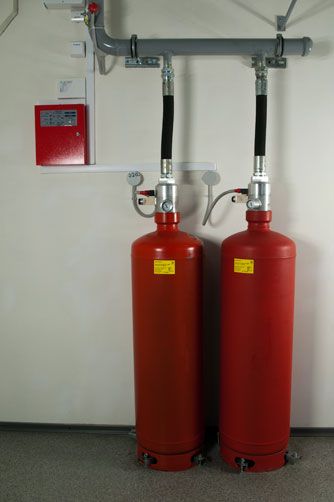
Of course, there is. About 100 video surveillance cameras, standard weapon. Pass through RFID tags (cards).
Some cameras are not used to monitor security, but to monitor equipment. Of course, everything is written to the archive.
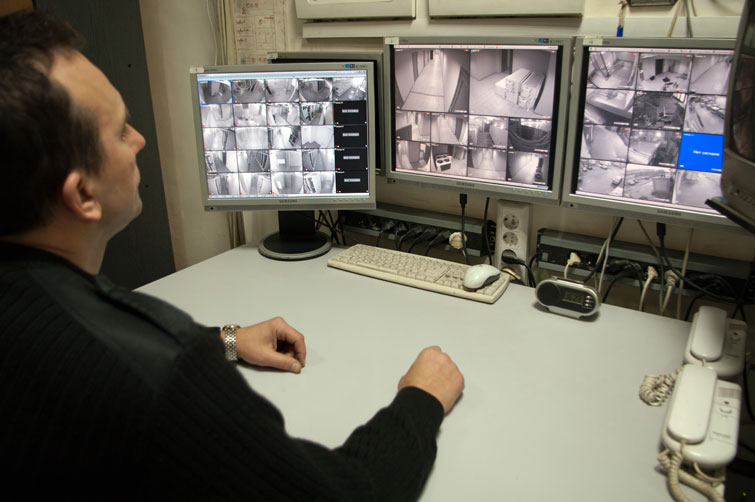
In this series of articles, we show how our DC look like.
So, the oldest data center of Selektel (from which the company, in fact, started), under the code name "Technodom" .
')
Video
A small video tour:
Server
It is also a machine room, payload (literally) for any data center. It is here that there are small pieces of fused silicon, for which all the rest of the equipment and people work.
(pictures are clickable)

Traditionally, the main format used for server placement is 19 "(19 inches), their height is measured in units (vershok, hehe). Servers are tightly mounted one above the other in special cabinets with vertical rails. Cabinets are sometimes also called" resistant ". In Technodom, 42 U cabinets are used in size (the inner rails have a height of 42 units, plus a little below, plus a little on top, plus a little from the sides to the walls and space for cables - that is, the actual size of the cabinet is larger than 1.8 meters high and 48 centimeters in dl well). The actual useful cabinet load somewhat less, as there still are mounted outlet (also 19 "). The dimensions of the cabinet itself: height 2030, width 600 mm. The depth of the cabinets is different - 620, 820 and 1020mm to choose from.
(under the cut - more photos of the server, equipment and people)
<habracut />

Selectel traditionally uses the cold corridor model: Cold air under pressure is injected into the corridor, from where server fans take it and thrown into the “hot corridor”, which is not, in the first place, hot, and secondly, not the corridor - this is all free server space except the "cold corridors". The cold corridors are really cold, it's uncomfortable for a long time there. The SLA recorded a promise to keep the temperature there + 20 ± 2 ° , degrees, in reality there are usually these same + 20-2. And taking into account the constant cold drafts from ventilation (in this place and all 15 degrees can be), this place is definitely not for humans.
A cold corridor is formed by two rows of cabinets (they make the side walls of the corridor), a roof on top and light doors on both sides of the corridor.
All servers are mounted so that the air intake slots face the cold corridor (usually the server faces), and the hot air is blown out (it is taken by the air-conditioning system, chased through filters, dried / moistened, cooled, and started back into the cold corridor ).
In the photos server side view in the cold corridor. The total area of DC is three and a half thousand square meters. Useful capacity - 320 cabinets (13440 units), placed on 1400 square meters of server space.

Unification does its own (black?) Business - despite the fact that these are photos of three different cold corridors, you can understand that they can be different only by this proposal (consider this a game of attentiveness - find 16 differences between the corridors).
Most servers have power connectors, network connections, etc. from the “hot” side, so that all work on switching, connecting / disconnecting, etc. it is from there.

This photo clearly shows the horizontal cable channel - it is used to connect the servers to the network (and among themselves).

Gloomy cooling chambers
So that in the cold corridors it was
We did a little bit differently - the coolers are placed in the pass-through corridor that protects them from rain and bird bombardment.

On both sides of the fan to blow hot air from the air conditioner. A standard N + 1 scheme is used (that is, an idle hotspar costs). Lessar air conditioners.
It is a close-up view:

Electrical
What is more important for a data center - electricity or the Internet?
3 megawatts of power. Of course, bespereboynik and diesel generators. Probably, there should tell a lot of interesting things about electricity, but this is not my element. I can only say that, for example, they don’t allow me to enter the premises of the electric economy (there is no necessary access - there are six kilovolts). Two inputs are serviced by 4 transformers, 380 volts are going to the boards, the usual 220 are already going to all the equipment.

Pay attention to the battery - at the time when the entire civilized server is cooled, the container with the generator is heated. Blinds (horizontal metal strips) are automatic, open simultaneously with the inclusion of the generator.
Generators - 4 pcs. Three are located on the street, one, just in case, in the building (in a separate room with separate ventilation, of course). Start automatic.
Periodically (about once a month) they are turned on for testing, according to my impressions I can say that the burned diesel fuel for several megawatts does not smell very good.
A little about diesel generators (I went to the technical director for details) - each diesel generator has two starters, their own bespereboynik to start (already two pieces).
Below you can see one of these batteries:

For a while, while the generators turn on, of course, there are uninterruptible power supplies. They are in a separate room. These are industrial electric packs of General Electric, collected in 4 clusters (plus traditional hotspars).

Connection
What is more important for a data center - electricity or the Internet? In fact, the “Internet” is too narrow a concept for a DC, connectivity is important for it. Not all links leaving the data center are the Internet, many of them are private networks, gray fibers that combine individual servers into a single structure, etc.
All DC Selectlel have links to each other through our optics. (Map of the passage of links: selectel.ru/services/rentvols )
Holy of Holies, communications site:

Of course, there are direct links to places of maximum Internet concentration in the city - Borovaya, 57 and Bolshaya Morskaya, 18. In addition, there are several operators in DC: RunNet, Retn.Net, Megafon, OBIT, Raskom, MTS, Comstar-UTS. There are two entrances of optics to the building - through the well and by air (backup line).
Fires and their extinguishing
Strange as it may seem, fire extinguishers and video surveillance are the main means of extinguishing fires. If this does not help, then there is heavy artillery - a gas fire extinguishing system.

Security
Of course, there is. About 100 video surveillance cameras, standard weapon. Pass through RFID tags (cards).
Some cameras are not used to monitor security, but to monitor equipment. Of course, everything is written to the archive.

Source: https://habr.com/ru/post/136071/
All Articles